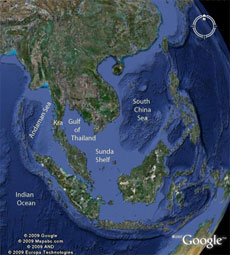New Explanation for a Puzzling Biological Divide Along the Malay Peninsula
March 5, 2009
By: Susan Brown

Over the past few million years the shallow Sunda shelf-shown pale blue in this view of Earth-was often dry land.
Credit: Google Earth
Ecologists at the University of California, San Diego, offer a new explanation for an apparently abrupt switch in the kinds in of mammals found along the Malay Peninsula in southeast Asia - from mainland species to island species - in the absence of any geographical barrier.
An ancient seaway between the Gulf of Thailand and the Andaman Sea was once thought have split the peninsula in two, allowing separated populations of animals to diverge. But a recent revision of the history of sea levels reveals that the ocean hasn't cut through the peninsula in the past 40 million years. Current species of mammals are much younger than that.
Instead, David Woodruff, professor of biology at UC San Diego and former graduate student Leslie Turner, now at the Max Planck Institute for Evolutionary Biology in Ploen, Germany, say that more than 58 rapid sea level rises in the last 5 million years could account for the shift by crowding out species, particularly at the narrowest part of the peninsula called the Isthmus of Kra. The Journal of Biogeography posted their findings online February 25.

Sixteen thousand years ago surrounding seas were 110 meters lower than today. Maps drawn by Clara Simpson, Field Museum, University of Chicago.
For most of the past few million years, the shallow ocean shelf surrounding the peninsula and islands of Malaysia and Indonesia has been exposed, creating a land area about the size of Europe. That habitat shrank dramatically each time sea levels rose.
"The ocean is coming from both sides repeatedly to squeeze things," Woodruff said. "If you have the ocean edge coming back and forth more than 50 times around this little narrow area, you'll compress the fauna and cause species to go extinct locally."
By consulting published reports, Woodruff and Turner mapped the ranges of 325 species of mammals found in the region. "We studied mammals from China down to Singapore," Woodruff said. But they found no evidence for a sharp transition between types of mammals at Kra or anywhere else along the peninsula.

Repeated exposure and flooding of the shallow Sunda shelf shaped the distribution of animals in the now watery world of Malaysia and Indonesia.
Instead, they saw a gap. "We found an area about 600 kilometers long where there are 30 percent fewer species than there should be," Woodruff said. Although 128 mainland Asian species stopped before the southern tip of the peninsula and 121 island species were found only in the south, 35 widely distributed species were found above and below the isthmus, but were missing from that narrowest part.
Related LinkIn The News: Sea level rises help explain puzzling biological divide
